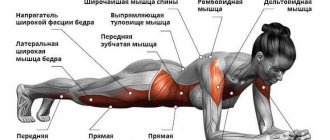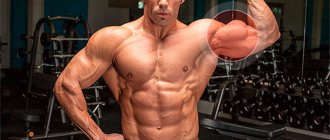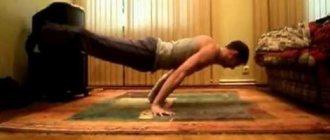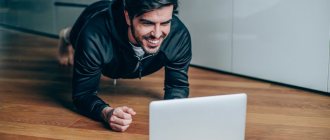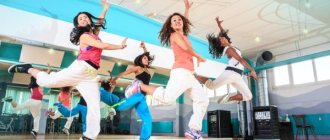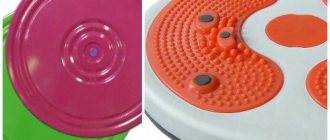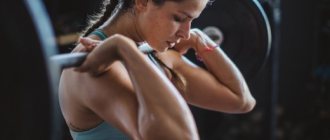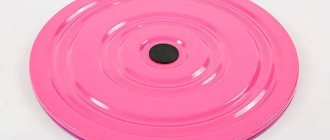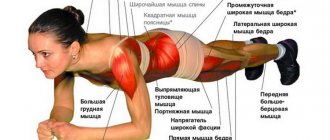You may never work out your abs if you don't strive to see six-pack abs on your stomach. But everyone needs to make a plan! The fact is that the plank exercise is not an isolating exercise, and it is not aimed at training the abs. It can be called a basic general strengthening exercise for the core muscles, which are not involved in other exercises, but are very important for stabilizing the body.
How long can you stand on one leg without leaning to the side? If it's just a couple of seconds, it means you have weak inner core muscles. And the daily plank is the best way to “educate” your balance.
What muscles are involved in the plank exercise?
To a greater extent, the exercise is focused on strengthening the core muscles, especially the abdominal and back muscles.
The abdominal muscles are stabilizing muscles that help maintain balance throughout the body. They are responsible for the balanced position of body parts relative to each other during the exercise. They also maintain the structural integrity of the abdominal organs that support the digestive and respiratory systems.
Other muscles that have important stabilizing functions include several muscles in the legs and back: the gluteus, rectus femoris, adductor group, back extensors, and lower and middle trapezius. All of these muscles are used in the plank.
“Stabilizers” are characterized by weakness. They are best trained through isometric (static) exercises or low-amplitude exercises using your own body weight.
As we can see, the plank is an ideal exercise for strengthening the stabilizer muscles.
Is it possible to pump up your abs with a plank and make them sculpted?
People are sure that since the abdominal muscles become very tense while doing the plank and may even hurt after this exercise, this means that the muscles are “pumped up”. Alas, this is not true. Let's generally figure out what we need to make the abs look sculpted:
- Genetics. It is genetics that is responsible for the number of coveted abs on the stomach. Several tendons cross the muscle, forming several paired vertical sections that resemble cubes. Usually there are 3 of these tendons, sometimes there are 4 and even 5, but rarely.
Look at the girl’s abs - not a single usual six-pack, although the oblique abdominal muscles indicate that their owner is extremely active.That is, every person has a certain number of abs - they are clearly visible in photos of professional athletes. For some they are more pronounced, and for others they are barely distinguishable due to the special structure of the tendon bridges and the thickness of the wall of the muscle itself. We cannot influence these factors by exercise or in any other way.
- Burn belly fat . Here, we hope, everything is clear. No matter how pumped up your muscles are, they will not be visible under a large layer of fat, so if you want to admire your sculpted abs, limit your caloric intake.
- Growth of the muscle itself. The cubes are actually located on one muscle - the rectus abdominis muscle, which we nicknamed the abs. In order for the cubes to stand out more clearly and the tendon bridges to “tighten” them more clearly, you need to make the muscle thicker, larger, i.e. pump it up, increase its size.
For this, as for pumping up any other muscle, we need: a load that will be sufficient to create microdamage to the muscle fibers, which means that we need an exercise with weight + an exercise that will ensure pumping of the muscle (bloating and damage from blood), construction material so that the muscle has something to grow from (protein) and time for recovery .
Let's now evaluate the plank exercise based on the prerequisites described above. Yes, during the plank position we tremble, sweat and tense every cell of the body, but does this mean that the muscles are swaying? The thing is that it does not contract and this does not lead to muscle development.
The muscle receives an isometric, static load, the exercise has an effect on your endurance and overall strengthening of the body, but does not cause movement of the joints, and therefore the muscles, and therefore does not affect their growth, only indirectly and as an additional load.
The plank will allow you to create a strong abdominal muscle corset, but you won’t be able to pump up your abs with the plank. But it’s ideal for creating a solid foundation for working out the abdominal muscles.
Benefits of planks
✅ The plank affects posture. By strengthening your core muscles, you can improve your posture, as the condition of your internal abdominal muscles affects the position of your neck, chest, back and shoulders.
✅ The plank allows you to tighten your stomach. And also make the abdominal wall more compact by strengthening the internal muscles. But the bar will not get rid of subcutaneous fat without following a diet❗
✅ Plank improves flexibility. When performing the exercise, you stretch the muscles of your back, arms, hips and even feet. Static load with your own weight helps maintain healthy joints.
✅ Plank speeds up metabolism. By doing the exercise daily, you stimulate your metabolism and keep it at a high level throughout the day.
✅ The plank improves body position stabilization. This is very important when performing many exercises, when one part of the body must remain motionless relative to the one that is directly involved.
And that is not all!
It's better to see once than to read a hundred times. Especially for those who want to quickly master the “Plank” exercise, there is a video in which an experienced trainer not only introduces the technique, but also gives useful recommendations:
And the last piece of advice from the editors: to make the effect of exercise more noticeable, carefully monitor your diet.
A properly performed plank will definitely strengthen your muscles, but to see relief, you need to get rid of excess fat.
Therefore, complement the 30-day program with a balanced diet, and you will definitely see positive results!
Does planking help you lose weight?
The effectiveness of any exercise is measured by the number of calories burned. For a minute of doing the plank, you will spend from 5 to 12 calories. Where 5 is the calorie consumption when performing a classic plank, and 12 is dynamic and with additional weight. Even if you do 3 sets of 2 minutes, you will only burn between 30 and 70 calories.
The plank will not get rid of the regimen and balance of nutrition and cardio activity - the main tools for “cleaning” the abdomen and sides. But it helps to visually make your figure slimmer by toning all abdominal muscles, including internal ones.
Plank with limb extension
We make our task as difficult as possible.
How to do it: get into a classic plank position. Extend your arm forward parallel to the floor. We start with thirty seconds. We return to the starting position. Then we repeat the same thing, but with the leg raised. We perform the technique for the other arm and leg. You can complicate the task if, together with extending your arm or leg, you make various movements in the air, alternately pulling the knee of the same name towards your arm, turning your head to the sides for better body work.
Tip: While in any type of plank, keep your abdominal, arm and leg muscles tense. This distributes the weight evenly and reduces the strain on your back.
Knee Pull Variation
Exercise Basics: How to Do a Plank Correctly
The most important thing in performing the exercise is to take the correct starting position. Perform in front of a mirror to better control your technique.
⚠️ Four points of an ideal plank:
- Don't let your midsection sag or stick your butt out. Maintain a straight line from head to toe throughout. The lower back should be as flat as possible.
- We lean not on our palms, but on our elbows/forearms, placed shoulder-width apart. The elbows should be strictly under the shoulder joint. Brushes can be closed into a lock.
- The core muscles are tense throughout the exercise. The stomach is pulled in, the pelvis is twisted forward, towards the hands.
- The closer your feet are to each other, the more difficult it is to maintain balance, and the greater the load on the abdominal muscles.
Be sure to breathe! Evenly and deeply, so that the muscles are saturated with oxygen. With a static load, you want to hold your breath, but you don’t need to do this.
How to do it correctly
How to do the plank exercise? There are several types of technology. The following is the standard version.
- Required to kneel. Then you need to rest on your forearms, bending your elbows at a right angle.
- Your shoulders should be positioned directly above your elbows.
- At the bottom, support is provided on the toes, the torso is raised. The abdominal muscles are tense.
- There is no need to lift your buttocks up or bend your lumbar spine - your heels, hips and shoulders should remain in a straight line.
- Now you need to stay for a certain number of seconds. Beginners can start with 20 seconds.
- If such time is easy, then you can stand longer. With each execution, the execution duration is increased, for example, by 10 seconds.
In general, the duration can be completely adapted to your own capabilities (just don’t overdo it, it’s important to observe the measure everywhere). The main thing is that there is a result after performing the plank exercise.
How long to stand in plank
Focus on the number of 3-4 approaches . The minimum holding time in one position is 30-45 seconds , the maximum is 2-3 minutes . You should not increase the duration to 5 minutes or more, as many advise. Most likely, the muscles have already adapted to the load and it will be more effective to complicate the load and move from the classic plank to advanced options.
If you are just starting to practice, 30 seconds will be enough the first time. Every day, try to add a few seconds per set. Don't race against time until you learn to hold the correct position ☝

